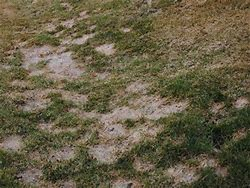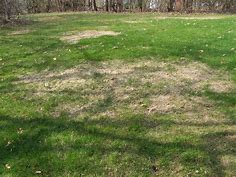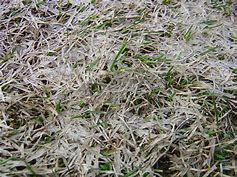In late winter and early spring when the snow has melted and a hint of spring is in the air. Depending on the condition and turf species in your lawn you may see irregular patches of brown grass that may be visible now that the snow has melted. In fact some of those brown patches developed rapidly following the snow melt when air temperatures climbed rapidly into the 60’s and 70’s. These patches were likely Snow Mold, a cold-weather fungal disease that typically affects cool-season grasses in our neck of the woods. We noted several properties including our own that were affected.
Both Gray and Pink snow mold can occur on many of our lawns in most winters, but are typically most severe when we have heavy, deeper snowfall before the ground freezes. The combination of excess moisture, leaf debris, taller, matted turfgrass, fragile, predisposed grass plants, and the right air temperature provide the perfect environment for these fungi to grow. Gray snow mold activity stops when temperatures exceed 45 degrees F and/or the lawn surface begins to dry, while Pink snow mold will continue to grow when temperatures are between 32 degrees F & 60 degrees F and weather conditions remain moist.


Generally Gray snow mold only adversely affects the grass blades, while Pink snow mold (if severe) can damage the crown and roots. Although most of our cool season turfgrass species can be affected by snow mold, Bentgrass, Perennial Ryegrass, Roughstalk Bluegrass and Annual Bluegrass are typically affected more severely. The Kentucky Bluegrasses, Fine Fescues and Tall Fescues seem to have better resistance to these two fungal diseases.

Prevention is the most effective strategy to minimize snow mold. In the fall, continue to cut the lawn until it stops growing. Rake up all leaves or mulch them into the lawn. Manage your thatch layer through Core Aeration and Dethatching (available through Elliott’s Lawncare LLC.) to maintain a minimal thatch layer of ½ inch or less and try to minimize large snow piles to encourage more rapid snow melt. Once you notice snow mold in your lawn, simply use a leaf rake to lightly rake up the matted areas to promote improved air circulation and drying of the affected areas. In the majority of cases that is all that it takes. Long term in some situations, it may be worth investigating renovating patches of Bentgrass or Roughstalked Bluegrass and replant those areas with more resistant turf species that match the general blend of your overall lawn. In some cases where large areas of Bentgrass is the predominant species, fungicide applications may be recommended (i.e. golf courses, bentgrass lawns, etc.), but in the majority of cool season lawn environments this would not be suggested.

Recent Comments